Are you interested in China’s world-renowned sites? Our China Student Tours to Beijing will satisfy your desire. In Beijing, you will see the magnificent Forbidden City, stately Tian’anmen Square, curving Hutongs with strong traditional Chinese characteristics, and many more. As the capital of many dynasties in Chinese history, Xi’an is absolutely a city with a long history. Thus, the China Student Tours to Shanghai also include the visit to Terra Cotta Warriors and Horses Museum, Small Wild Goose Pagoda, and other scenic spots full of local features. In Shanghai, you will be appealed by the charm of the Bund, Oriental Pearl Tower, Zhujiajiao Water Town, and so on. All of these will make you astonished by the great Chinese civilizations. After watching them, you will be filled with admiration for ancient Chinese people’s wisdom. I believe it will be the Best China Student Tours in your mind.

Upon your arrival in Beijing, your guide is waiting for you with a pick-up card at the airport. Then the guide will transfer you to a hotel.
In the morning, you will visit Tian’anmen Square covering 4,800 square meters. Located in the downtown area of Beijing, Tian’anmen Square was built in 1417. There are 5 gates in Tian’anmen Rostrum, among which the middle one is the largest, located on the central axis of Beijing. In the Ming (1368-1644) and Qing (1636-1912) Dynasties, only the emperors were allowed to pass the middle gate. However, on some special occasions, the following people were also permitted to walk through the middle gate. Emperors’ parents were allowed to pass the middle one. When the emperor held the wedding ceremony, the empress could pass through the middle gate. When the new number one scholar paid a formal visit to the emperor, he was allowed to walk through the middle gate. In ancient China, there was an imperial competitive examination that was used to select talents for the royal family. The person who gets the highest mark is called the number one scholar. Except for the mentioned occasions, no one is allowed to walk through the middle gate. Otherwise, the violator will be punished severely. The rest gates can be available for the royal families and officials.
Then you will visit the Forbidden City (Closed on Mondays) which is the royal palace of the Ming and the Qing Dynasties, covering 720,000 square meters. The Forbidden City is divided into the outer court and inner court. The outer court consists of the Hall of Supreme Harmony, Hall of Central Harmony, and Hall of Preserving Harmony. The Hall of Preserving Harmony is 29 meters tall, covering an area of 1,240 square meters. It was the place where the emperor gave banquets to princes and dukes every New Year’s Eve. Besides, the final imperial examination is also held here. In ancient China, there was an imperial competitive examination every three years to select professionals for the royal family. The examination is divided into 3 levels. Only those passing the first two exams are qualified to take the final imperial exam. In the last round, the emperor set questions for the examinees in the Hall of Preserving Harmony.
After visiting it, you will have lunch.
In the afternoon, Student tours to Hutong begin with Confucius Temple, which covers 22,000 square meters. It is a place to memorize Confucius in the Yuan (1271-1368), Ming and Qing Dynasties. There are three courtyards in total. The buildings on the central axis are Dacheng Gate, Dacheng Hall, Chongsheng Gate, and Chongsheng Shrine from south to north. There is a well in the west of Dacheng Hall, which was given the name Yanshui Lake by Emperor Qianlong. In Chinese, yan means inkstone; shui means water. It is said that after visiting Confucius in Confucius Temple if the examinees drank the "holy water" from the well, they would be smarter while sitting for the imperial examination. If they used the ink made of the water from the well, they will exert extraordinary potential on the examination hall.
If you are interested in Hutong (a kind of narrow alley in Beijing), then the rickshaw tour will satisfy you. There is a sort of distinctive dwelling named Dazayuan, referring to a large courtyard. The Dazayuan was generally rebuilt from the quadrangle courtyard and is mostly dilapidated. Unlike a quadrangle where only one family lived, a Dazayuan was a place where many families lived. The neighbors in a Dazayuan were on good terms with each other. Whoever cooked a good meal at home would call his neighbors to come and eat. If someone in the Dazayuan got married, on the day of the wedding, not only the family holding the wedding was busy, but the neighbors in the Dazayuan were also busy helping. As for the Hutong Family visit, the rickshaw driver will take you to a quadrangle dwelling whose owner will tell you some stories about the Hutong and the quadrangle dwellings.
After that, your guide will take you to the hotel for a good rest.

In the morning, you will visit the Chang Tomb of the Ming Tombs, which will take you an hour to arrive there, since it is 48 kilometers away from downtown Beijing. Built between 1409 and 1645, the Ming Tombs cover an area of 40 square kilometers and are the largest surviving imperial tomb complex in China and the world, with a total of 13 Ming emperors' tombs. Covering 120,000 square meters, the Chang Tomb is the largest one among the Ming Tombs, where emperor Zhu Di and his empress were buried. Why the Chang Tomb gains its name like this? The character Chang refers to the senior. As the owner of the first tomb in Ming Tombs, he was the initiator and the senior of the Ming Tomb undoubtedly. The other meaning of Chang is that Zhu Di could rest here in peace and witness the continued reign of his descendants over the land.
After lunch, you will visit Mutianyu Great Wall, 44.5 km away from the Chang Tomb. It will take you an hour and fifteen minutes to arrive there by car. Mutianyu Great Wall is a section of the Great Wall built in the Ming Dynasty, with a length of 5.4 kilometers. The round way cable car is provided. Additionally, there is a graffiti wall on the Great Wall where you can leave your feelings. Since all the Great Wall is banned to scrawl, the graffiti wall is set for tourists.
After visiting these spots, you will be sent back to the hotel.
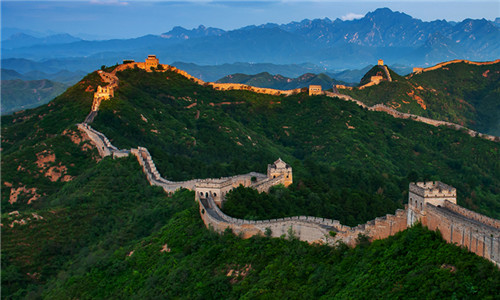
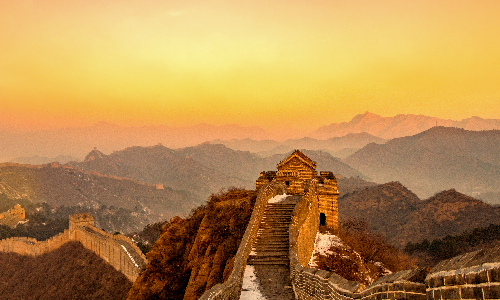
After breakfast, you will visit Beijing Zoo, covering about 86 hectares. The Panda House in the zoo is worth visiting, covering 10,000 square meters. According to the requirements of animal rearing and exhibition, the exhibition house is divided into three parts: adult pandas, young pandas, and child pandas. In summer, the panda house is filled with "fairy air" as the pandas move slowly through the cool water mist. The fairy air is an outdoor cooling spray, specially prepared for the pandas, for 20 seconds at a time, for 2 - 3 minutes. In the Panda House, you can watch such cute animals as pandas closely.Then your next destination is the 798 Art Zone which has become a new landmark of Beijing city culture, covering more than 600,000 square meters. It was originally a place where many factories gathered in the past. Now, numerous artists and cultural organizations transform vacant factories into galleries, design companies, and so on. In 2003, the 798 Art Zone was rated by Time magazine as one of the 22 most culturally iconic art centers in the world.
In the afternoon, you will visit some universities. Which university you will visit depends on the actual situation at that time.
After finishing the visit to the universities, you will be sent to the hotel.
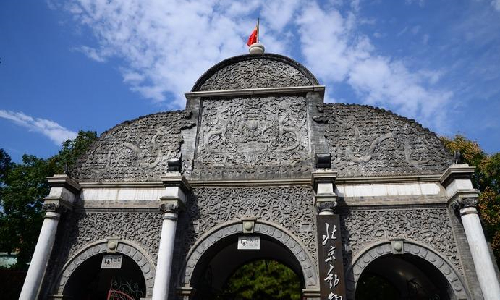
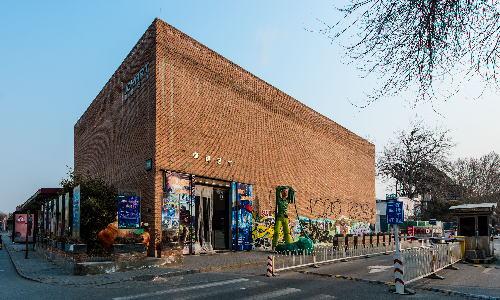
 Xi’an
Xi’an After breakfast, you will visit the Temple of Heaven covering 2,730,000 square meters, where you will learn Tai Chi. Built in 1420, it is a place where emperors worshiped heaven and prayed for a good harvest in the Ming and Qing Dynasties. There is a Danbi Bridge that is 360 meters long and 30 meters wide. Actually, it is not a bridge but an avenue. There is a tunnel with a gate under the bridge. The gate is named Jinsheng Gate. In Chinese, jin means pass; sheng means livestock. The livestock for sacrifice is transported through the tunnel to Sacrifice Pavilion and is made into articles of tribute. The livestock entering the gate must be dead, so the gate is also named the gate of hell.
After lunch, you will be transferred to the train station where you will take the estimated train G57 14:00/18:24 to Xi’an.
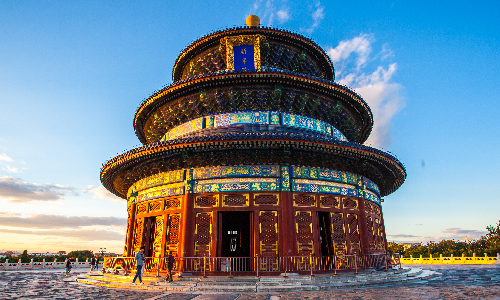
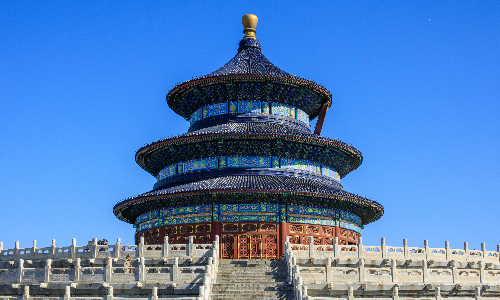
In the morning, you will visit the Terra Cotta Warriors and Horses Museum, 42 km away from the downtown area of Xi’an. It will take you 1 hour to reach there. There are 3 pits filled with terra cotta warriors and horses in total. The first one is full of warrior figures with bows and crossbows in their hands. The second one is filled with knights, infantries, and chariots. The last one is the general headquarters commanding all warriors, consisting of 68 terra cotta warriors.
After lunch, you will go to the Small Wild Goose Pagoda(Closed on Tuesday) which is located in the Jianfu Temple, 50 kilometers away from Terra Cotta Warriors and Horses Museum. You will spend one hour and ten minutes arriving there. Built in 707, it is 43.4 meters tall with 13 storeys. Besides, there is Tang Dynasty (618-907) Dhvaja (stone pillar with Buddhism lection and joss), Tang Dynasty Stone Buddha Statue, and an Iron Bell in the Jianfu Temple. The Tang Dynasty Stone Buddha Statue is the largest stone Buddha statue of the Tang Dynasty, discovered near the Small Wild Goose Pagoda. If you are interested in Chinese calligraphy, you can attend a calligraphy class in the Small Wild Goose Pagoda to learn some Chinese characters. The ink brushes and paper are offered.
Next, you will visit Xi’an Old City Wall which is 12 meters tall, with a perimeter of 13.74 kilometers. It is the largest and best-preserved ancient city wall in China. Xi’an Old City Wall is made of 26 million bricks. If we use these bricks to pave the road, the length of the road is five times the distance from Xi’an to Shanghai.
Then you will be sent to the hotel.
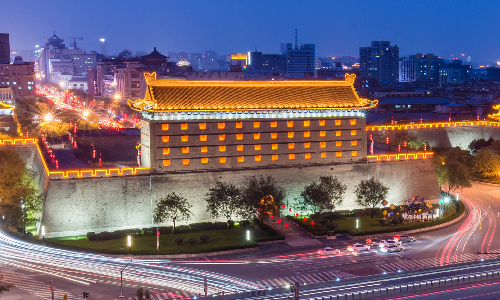
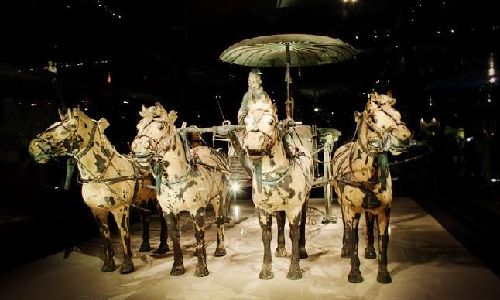
 Shanghai
Shanghai In the morning, you will be transferred to the train station where you will take the estimated train G362 08:55/15:06 to Shanghai. Lunch boxes are offered to everyone. Upon arrival, you will find your guide waiting for you at the station.
Your first destination in Shanghai is the Xintiandi Area, located in the center of Shanghai, which is a pedestrian street combining dining, business, recreation, and culture. There is a distinctive kind of traditional dwelling known as Shikumen. The door frame of Shikumen architecture is made of stone, which is not only hard but is an embodiment of social status. The brick walls, tiles, and stone gates of such architecture are preserved well. If you enter one house, you will feel like that you are back in the 1920s. However, each house is equipped with modern devices. Many of them have been transformed into bars, galleries, restaurants, and boutiques.
Then you will go to the Former French Concession which was the most upscale residential area in old Shanghai, with uniform architecture. Sinan Mansions is worth visiting. Boasting 51 garden houses, there are also numerous architecture styles in Sinan Mansions, including modern apartments, gallery and lane houses. The Hotel Residence of Sinan Mansions is an important part, consisting of 19 garden houses, 2 galleries, and 1 recreation club. You will have a good time wandering around the Former French Concession.
At the end of today’s trip, you will be sent to the hotel.
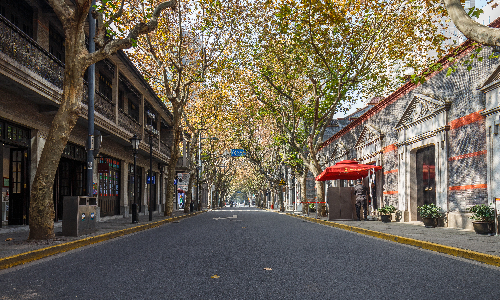
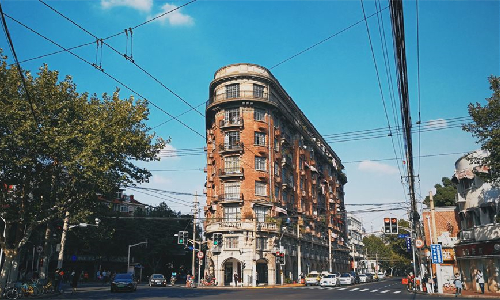
After breakfast, you will visit Jade Buddha Temple which is well-known for the Jade Buddhas in the temple. Covering 8,856 square meters, it was built in 1900, with the architecture style of the Song Dynasty (960-1279). There is a statue of Avalokitesvara Bodhisattva made of jujube wood in the Ming Dynasty, 1.5 meters tall. It is carved from a whole jujube tree.
Then you will go to Yu Garden (Closed on Mondays) which is a private garden, built in the Ming Dynasty. There are two iron lions made in the Yuan Dynasty (1271-1368) in the Yu Garden. The right one is a male whose left paw treads on a ball, representing authority and majesty. The left one is a female stepping on a little cub, symbolizing growing generations. Moreover, the Nine-dragon Pond is also an attraction. There are four dragons carved from stones on the pond wall. Counting the reflections in the pond water and the pond that meanders like a dragon, there are nine dragons in total. Hence, it gains its name.
The next spot is Shanghai Old Street which is a place for foreign trade and business. The multifunctional street combines sightseeing, shopping, entertainment, and culture. Shanghai Old Street is divided into east and west sections with Guanyi Street as the boundary. The eastern section, after decoration and renovation, retains the characteristics of the folk houses in the late Qing Dynasty. The facade of the houses in the west section emulates the buildings of the Ming and Qing Dynasties, highlighting the folk customs of the old city of Shanghai, with black tiles, white walls, red columns, and flying eaves.
After lunch, you will visit People’s Square. Covering 140,000 square meters, it was the place where the upper class held horse races and other activities in the past. Now it is a garden-style square integrating financial administration, culture, transportation, and commerce.
Then you will go to the Shanghai Museum (Closed on Mondays) which is the essence of the Shanghai tour for students. Covering 11,000 square meters, it is 29.5 meters tall. The building is a combination of a square base and a round top, signifying the ancient Chinese belief that “the sky is round and the earth is square”. There are numerous cultural relics in it, such as bronzes wares, china wares, paintings, and calligraphy. The exhibition hall for ancient coins deserves a visit where many kinds of coins of different dynasties in Chinese history are displayed. If you watch them, you will be amazed by ancient people’s wisdom.
The last spot of today’s trip is Oriental Pearl Tower which was built in 1994. Known as the highest tower in Asia, it is 468 meters high. The overall ratio of the Oriental Pearl Tower is called the “golden ratio”. In mathematics, 0.618 is called the golden section. All the data have been professionally and mathematically calculated. This is the reason why the Oriental Pearl Tower can still persevere in a 12 - magnitude typhoon and in an 8 - magnitude earthquake.
Then you will be sent to the hotel.
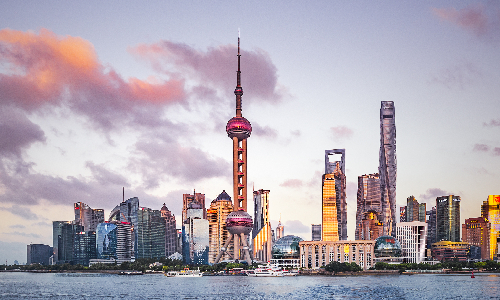
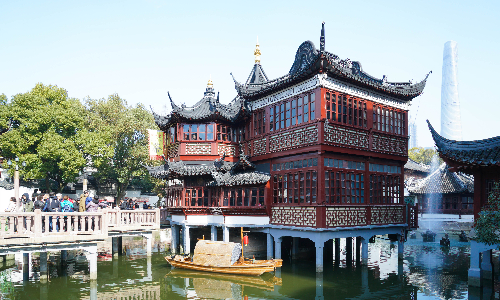
After breakfast, you will go to Zhujiajiao Water Town, 49 kilometers away from Yu Garden. It will take you an hour and thirty minutes to arrive there. Upon Zhujiajiao Water Town, you will take a boat to enjoy the scenery. Zhujiajiao people have the custom of drinking morning tea. Every day before the morning fog, the teahouse has long been full of laughter. Tea drinkers sip tea while talking about social news and the business and development of the town. They exchange all kinds of information with each other. There are also tourists who come to sit in the teahouse, drinking local tea, looking across the river at the beautiful green mountains, and enjoying the special scenery of the Chinese countryside. If you are interested, you may want to go to taste a taste.
Lunch will be offered in Zhujiajiao Water Town.
In the afternoon, you will be driven downtown and visit the Bund, which is 1.5kilometers long, known as the location of the exotic building clusters. Fifty-two classical Revival buildings in different styles stand on the Bund. The Custom House is undoubtedly an amazing one. The bell tower of the building was made in imitation of the great clock of the House of Parliament in London. The clock’s face is round and the pointer of the clock is made of red copper. The minute hand is 3.17 meters long and the hour hand is 2.3 meters long. There are 3 pendulums in the clock, and the largest one weighs 2 tons. Furthermore, the clock is also decorated with 72 automatic light bulbs.
Then you will visit Nanjing Road which is the firstly-established commercial street in China. By the 1920s, there were more than 300 shops on Nanjing Road. Hence, you will see plenty of time-honored brands. For example, LEGO Shanghai Flagship Store that is the second shop in Asia is located here. Whether you would like to eat or entertain yourself, Nanjing Road will meet all your expectations.
After finishing today’s agenda, you will be transferred to the hotel.
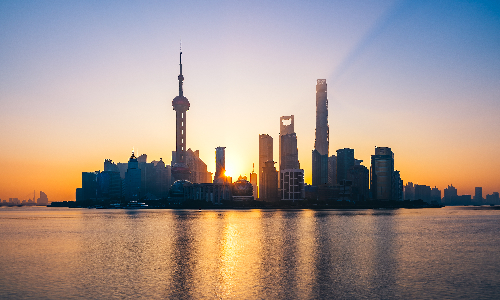
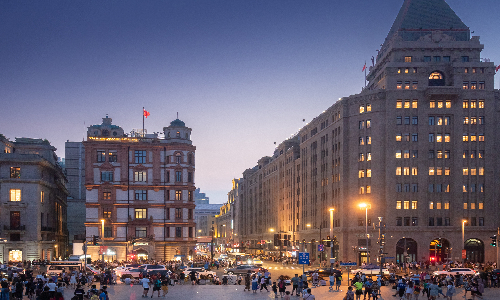
After breakfast, you will be sent to the airport. All of your services end here.
Author: Wang Chongchong
Proofreader: Lexie
| City | Five Star hotel list | Four Star hotel list |
|---|---|---|
| Beijing | Sunworld Dynasty Hotel Beijing Wangfujing | Sunworld Hotel Wangfujing |
| Xi'an | Tianyu Gloria Grand Hotel Xi'an | Sunworld Dynasty Hotel |
| Shanghai | Ocean Hotel Shanghai | Courtyard by Marriott Shanghai Central |
 |
![]() About your child or infant, please contact us for a discounted price.
About your child or infant, please contact us for a discounted price.



We started with a few days in Beijing & ended in Shanghai, from where we visited the Forbidden City and Great Wall. In between we visited Terra Cotta Warriors Museum, Panda Base, Shanghai Disneyland.

We had a wonderful holiday in China which will remain long in the memory. China is a breathtakingly beautiful country full of splendid temples and palaces, mountains and rivers, peaceful rural scenes and bustling shopping streets.
 QUICK ENQUIRY
QUICK ENQUIRY